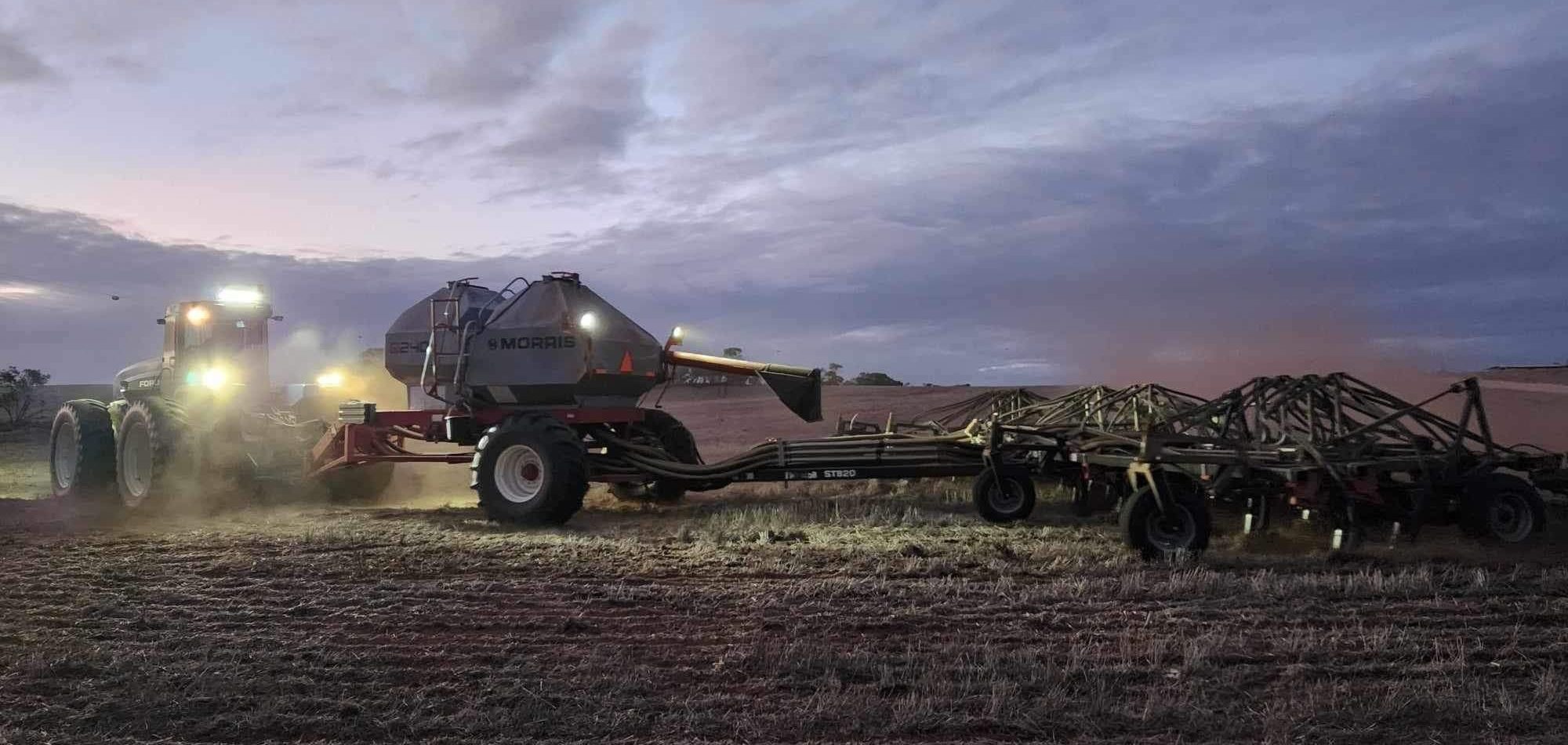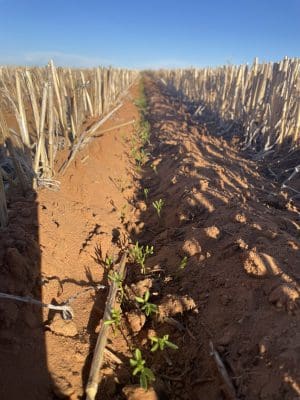
Lentils are being dry sown in South Australia ahead of the autumn break which is yet to appear on the seven-day forecast. Photo: Rebekah Starick
PLANTING of Australia’s lentil and faba beans crops is well advanced at the ideal time, with area on track to at least match last year’s.
Desi chickpea area is expected to be up considerably on last year’s, but prospects for all three crops will depend on rain over coming weeks.
Chickpea planting will start in Queensland and northern New South Wales in late May, and should wrap up in June, provided sufficient rain falls in coming weeks to top up subsoil moisture reserves.
Prompt prices for chickpeas and lentils have firmed in the past month based on bulk and containerised demand for dwindling current-crop stocks, while faba bean prices have softened.
All prices quoted are in Australian dollars.
Chickpeas
Based on solid demand from Pakistan, Bangladesh and others, bids from up-country packers are up by around $50/t since early April to $950/t for the prompt and new-crop markets.
Growers and traders remain hopeful the Indian Government will remove its tariff on Australian chickpeas once the result of the current election is announced in early June, and this speculation is also driving up prices.
At Walgett in north-west NSW, Outlook Ag director Greg Rummery said the region’s growers were ready to put in a big area of chickpeas following last year’s very dry season that severely limited planted area of all winter crops.
“I think our program for chickpeas is looking good; they’ll be our main rotation crop to go in, as well as a few faba beans and some canola,” Mr Rummery said.
“We’re a month off planting here; we typically don’t plant chickpeas until late May or the first week of June.
“Most people are planting wheat at the moment east of Walgett, and west of Walgett is looking for more rain.”
The Walgett district in 2016-17 produced around 300,000t of chickpeas, and hopes exist for around 150,000t from the upcoming plant.
Industry sources say the national chickpea crop sown to be planted is expected to exceed 1 million tonnes (Mt).
This is double the 531,000t ABARES estimates was harvested in 2023-24 from 409,000ha, but still well below the record set in 2016-17 of 2Mt from 1.1Mha.
NSW’s other major chickpea production areas of Narrabri, Moree and Mungindi, and southern Queensland, have enough subsoil moisture to plant.
In Central Qld, areas north of Emerald are looking for more rain once cotton is picked and sorghum has been harvested.
South of Emerald, rain that made a mess of mungbeans on the point of harvest has boosted prospects for wheat and chickpeas, its two dominant winter crops, which will be planted in coming weeks.
“For chickpeas, there’s good subsoil moisture from Emerald through to Dubbo,” one trader said.
Faba beans
Prices for faba beans delivered bulk port have dropped around $30/t in the past month to $550/t to reflect thinning bulk export demand.
South Australia is Australia’s major exporter of faba beans, and early indications are its area will be down on last season’s due to a swing into lentils in the state’s lower-rainfall areas.
Around one third of the national faba bean crop is thought to have been planted, mostly in northern areas.
Pinion Advisory consultant Jana Dixon said planting of pulse crops is under way in SA, despite the dry conditions.
“In the last week or so, quite a few people’s programs have started in the Lower and Mid North areas,” Ms Dixon said.
“When it’s dry and there’s no rain on the forecast, it’s lentils and beans that go in.”
No rain is forecast for SA growing areas in the next seven days, and some growers are waiting for a front to appear before they will turn a wheel.
Ms Dixon said SA generally had moderate subsoil levels, depending on soil type and the amount of summer rain received.
“The worry at the moment is the breaking rain event.”
She said lower-rainfall areas might trim their intended pulse area if good rain does not arrive soon.
“The more reliable areas will continue with pulse area as planned.”
In NSW, Victoria and southern Qld, some bean crops have germinated after being sown into good moisture.
Domestic demand for faba beans is one to watch.
Stockfeed millers may up their inclusion of fabas now that cereals are getting more expensive, and dry conditions in Western Australia, SA and pockets of eastern Australia push sheep on to rations where paddock feed is limited or non-existent.
ABARES data says Australia last year produced a crop of 554,000t from 264,000ha.
An official new-crop estimate is yet to be released, but something similar can be expected for the crop now being planted, with increased area in northern NSW likely to offset a possible decline in southern Australia if dry conditions continue.
Lentils
Nipper-type lentils for prompt bulk delivery to port are trading at around $940/t, up roughly $80/t since early April, when the larger Hallmark types were quoted at $850/t.
In SA, Pinion Advisory agribusiness consultant Chelsea Heinrich said the new-crop Nipper 1 market was sitting at around $830-$840/t.
The inverse between the prompt and new-crop markets reflects a rundown of stocks, and solid nearby export demand.
“India’s having a rough harvest themselves, and…Canada is dry in places,” Ms Heinrich said.
“Potentially, there’s another increase in demand coming.”

A crop of Thunder lentils is up and away at Nandaly in the Mallee district. Photo: Matt Witney, Dodgshun Medlin
Ms Heinrich said SA’s lentil stocks are low because growers have been happy to take prices on offer.
“In the past five months, we haven’t seen prices drop too much below $850; it’s been mostly $850-$900/t.”
“They might have held on to all of 100t and post-harvest; we’re really not left with a whole lot of lentils on farm.”
Likewise, bulk handlers have been using their current-crop stocks to fill a string of vessels and containers in a free-flowing export pathway to South Asia.
“Because of where we’re placed on the map, we’ve been able to price competitively.”
Containerised lentils bound for Egypt have not had it so easy, and have had to ply the lengthy detour around West Africa to avoid the risk of Houthi attacks in the Red Sea.
Growers in SA’s key lentil-growing areas on Yorke Peninsula and the Murray-Mallee, as well as the Lower and Mid North, have generally started planting lentils, and are happy to dry sow ahead of the expected autumn break.
Based on prices currently on offer, Ms Dixon said lentils remained “a very attractive proposition” for SA growers.
In the Victorian Mallee, Pearson’s Grain input sales manager Liam Barry said lentils were being dry sown.
“We haven’t had much rain lately; there’s plenty of subsoil moisture, but it’s dry enough on top,” Mr Barry said.
“A fair few have done their pulses and are moving into cereals.”
An official estimate for Australia’s lentil crop now being planted is yet to be released, but a kind growing season could see the most recent crop of 1.4Mt from 675,000ha matched.
Around one third to one half of the current crop is thought to have been planted, and given the dry conditions, the record crop of 1.7Mt from 646,000ha appears unlikely to be matched this season.

HAVE YOUR SAY